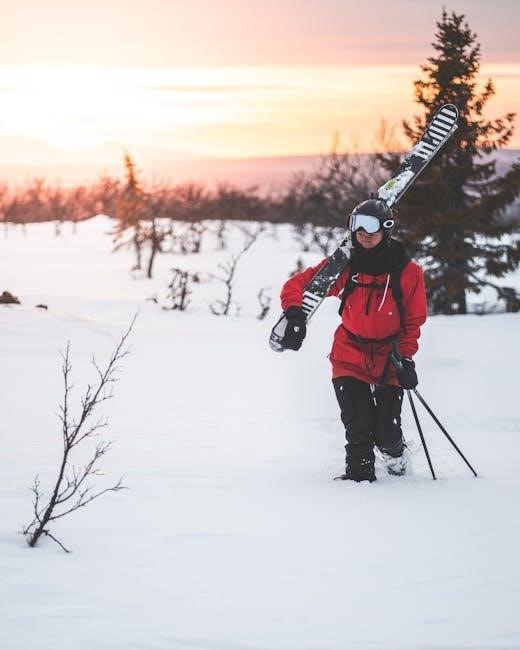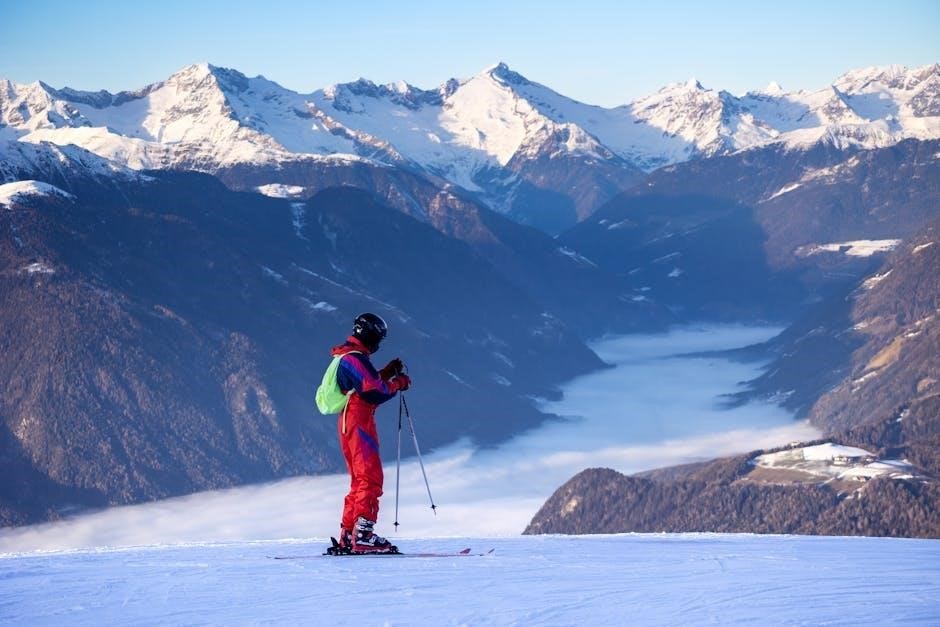ski sizing guide
Summary
Discover your ideal ski size with our easy-to-use guide. Get expert tips for a perfect fit and elevate your skiing experience!

Choosing the right ski size is crucial for optimal performance, control, and safety on the slopes․ Proper fitting ensures a balanced blend of stability and maneuverability, catering to individual needs based on height, weight, skill level, and boot compatibility․ This guide provides a comprehensive overview to help skiers of all levels select the perfect skis for their next adventure․
Whether you’re a beginner or an advanced skier, understanding how height, weight, and ability influence ski size is essential․ By following this guide, you’ll gain insights into key factors like ski length, boot fit, and geometry to make informed decisions tailored to your skiing style and preferences․
The Evolution of Ski Sizing
Over the years, ski sizing has evolved significantly, shifting from one-size-fits-all approaches to highly personalized fits․ Early skis were often uniform in length, but advancements in materials and skiing techniques led to tailored sizing․ Today, skis are designed to match individual needs, considering factors like height, weight, and ability․ This evolution ensures better performance, control, and safety, making skiing more accessible and enjoyable for all skill levels and preferences․
Key Factors in Determining Ski Size
Determining the right ski size involves evaluating multiple factors, including skier height, weight, ability, and skiing style․ These elements help tailor the skis to individual needs, ensuring optimal performance․ Proper sizing enhances control, stability, and maneuverability, making the skiing experience both enjoyable and safe․ By considering these key factors, skiers can choose skis that align with their unique preferences and skill levels, maximizing their time on the slopes․

Height and Weight Considerations
Height and weight are critical factors in determining ski size, as they influence stability and control․ Taller or heavier skiers often require longer skis for optimal performance․
General Rule of Thumb for Ski Length
The general rule for ski length is to measure between your chin and the top of your head․ Beginners often prefer shorter skis for easier control, while advanced skiers may opt for longer skis for stability at higher speeds․ This range provides a balance between maneuverability and float, ensuring optimal performance across various snow conditions․ Proper ski length enhances balance, stability, and control, making it a critical factor in choosing the right skis for your skiing style․
How Weight Affects Ski Performance
Your weight plays a significant role in determining ski performance, as it impacts how the skis interact with the snow․ Heavier skiers may require stiffer skis for better edge hold and control, while lighter skiers might prefer softer flex for easier maneuverability․ Weight also affects floatation in powder snow, with heavier skiers needing wider skis to stay afloat․ Proper ski size ensures optimal performance, balancing stability and responsiveness based on your weight and skiing style for a more enjoyable experience on the slopes․

Ski Length Based on Skill Level
Ski length varies by skill level, with shorter skis suiting beginners for easy control and longer skis benefiting advanced skiers for stability and speed․
Beginner Skiers: Finding the Right Balance
For beginner skiers, skis should generally measure between your chin and the top of your head․ This length provides optimal control and maneuverability, making it easier to learn basic techniques․ Shorter skis are more forgiving, allowing for better balance and confidence․ They also make turning simpler, which is crucial for mastering the fundamentals of skiing․ A properly sized ski helps reduce fatigue and enhances the overall learning experience, ensuring a smoother transition from novice to intermediate levels․
Intermediate Skiers: Optimizing Control and Speed
For intermediate skiers, skis slightly longer than those for beginners, typically reaching just above the head, provide the perfect blend of control and speed․ This length offers enhanced stability at higher velocities while maintaining maneuverability for tighter turns․ The additional length allows for better edge hold on groomed trails and adaptability on varied terrain, enabling intermediate skiers to refine their techniques and explore more challenging slopes with greater confidence․ Properly sized skis at this level ensure a smooth transition to more advanced skiing․
Advanced Skiers: Precision and Performance

Advanced skiers require skis tailored for precision and high-speed performance, often slightly longer than those for intermediates, reaching just above the head or taller․ This length enhances stability at high velocities, allowing for sharp, responsive turns and superior edge control․ The additional length and stiffer flex provide better absorption of shocks and maintain consistent performance on demanding terrains like steep slopes or deep snow․ Properly fitted skis for advanced skiers ensure maximum precision, power, and control, enabling them to tackle challenging conditions with ease and confidence․

Boot Size and Fit
Proper boot size and fit are essential for optimal skiing performance and comfort․ Boots should be snug but not restrictive, ensuring precise control and responsiveness while skiing; Correct sizing, often measured using Mondopoint standards, ensures compatibility with skis and bindings, enhancing both performance and safety on the slopes․ A well-fitting boot provides the necessary support and stability for skiers of all levels, from beginners to experts, ensuring a enjoyable and effective skiing experience․
Understanding Mondopoint Measurements
Mondopoint is a standardized sizing system measuring foot length in centimeters, ensuring precise fit for ski boots․ This system eliminates guesswork, providing accurate sizing for comfort and performance․ Full Tilt boots, for example, use Mondopoint, advising to size up if exact measurements aren’t available․ Proper alignment between boot size and skier’s foot length is crucial for control and efficiency on the slopes, making Mondopoint a reliable tool for selecting the right boot size tailored to individual needs․
Choosing the Right Boot Size for Your Skis
Proper boot sizing is essential for both comfort and performance on the slopes․ Mondopoint measurements provide precise sizing based on foot length in centimeters, minimizing guesswork․ Ensure your boots align with your foot length for optimal control and efficiency․ Even a small mismatch can hinder performance and comfort․ Always try boots on and consider factors like skiing style and boot flexibility to ensure the best fit for your skis and skiing experience․

Youth Ski Sizing
Properly sizing skis for youth involves measuring their height and skill level, ensuring the skis allow for growth and skill improvement․ This ensures optimal performance and safety․
How to Measure and Choose Skis for Children
Measuring and choosing skis for children involves considering their height, weight, and skill level․ A general rule is for skis to reach between their chin and the top of their head․ For younger kids, shorter skis (around 70-100cm) are recommended for easier control․ As they grow, skis can be adjusted to accommodate their height and improving skills․ Proper fit ensures safety, performance, and comfort, allowing children to enjoy skiing while developing their abilities․ Always consider growth potential when selecting skis for youth․
Adjusting Skis for Growth and Skill Development
Skis for children often need adjustments as they grow and improve their skills․ Youth skis can be extended or replaced to accommodate taller heights and stronger techniques․ Many modern junior skis feature adjustable bindings, allowing for incremental length increases․ As skill levels advance, transitioning to slightly longer skis helps maintain proper technique and control․ Regularly assessing a child’s height, weight, and ability ensures the skis remain suitable, promoting continued progress and enjoyment on the slopes without compromising performance or safety․

Tip-Waist-Tail Measurements
Tip-waist-tail measurements, shown as numbers like 131/98/119, indicate ski width at the tip, waist, and tail, influencing performance in different snow conditions and turning styles․

Understanding Ski Geometry for Better Performance
Ski geometry, measured as tip-waist-tail, directly impacts performance․ A wider tip enhances floatation in powder, while a narrower waist improves edge hold on groomed trails․ The tail’s width affects stability during turns․ These dimensions influence how skis behave across different terrains and snow conditions, ensuring optimal maneuverability and control․ Understanding these measurements helps skiers choose skis tailored to their preferred skiing style, whether carving on hardpack or exploring off-piste adventures․

Adjusting Bindings for Boot Size
Properly adjusting ski bindings ensures compatibility with boot size for optimal performance and safety․ Use a screwdriver to align boot sole length with binding marks․ Start with the toe piece, then the heel, ensuring a snug fit․ Refer to manufacturer guidelines for specific instructions tailored to your binding model․ Correct adjustment enhances control, stability, and responsiveness on the slopes․
A Step-by-Step Guide to Binding Adjustment
Adjusting ski bindings for boot size requires precision to ensure safety and performance․ Begin by placing the boot in the binding, aligning the toe and heel with the marks․ Tighten the toe screws until snug, then adjust the heel․ Use a screwdriver to fine-tune the fit, ensuring no play․ Test the release mechanism to confirm proper function․ Always refer to the manufacturer’s instructions for specific models, as adjustments may vary․ Proper adjustment ensures a secure, responsive connection between boot and ski, enhancing control and safety on the slopes․
The Importance of Proper Fit
Proper fit enhances performance and safety, ensuring optimal control and maneuverability․ It prevents issues like poor edge grip and inconsistent turning, critical for all skiers․
Poor fit can lead to a lack of control and increased safety risks, making it essential to prioritize accurate sizing for every skiing experience․
How Fit Impacts Ski Performance and Safety
Proper fit is critical for maximizing ski performance and ensuring safety․ A well-fitted ski boot and correctly sized ski enhance control, stability, and responsiveness, allowing for precise movements and better energy transfer․
Poor fit can lead to fatigue, reduced control, and increased risk of accidents․ Ill-fitting equipment may cause poor edge grip and inconsistent turning, compromising both performance and safety on the slopes․